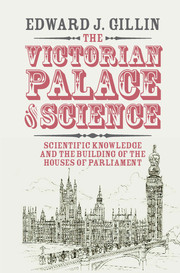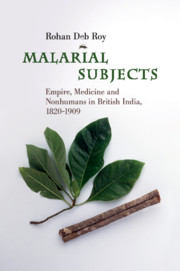Refine search
Actions for selected content:
10305 results in History of science: general interest
2 - Architecture and Knowledge: Charles Barry and the World of Mid-Nineteenth-Century Science
-
- Book:
- The Victorian Palace of Science
- Published online:
- 30 October 2017
- Print publication:
- 09 November 2017, pp 54-86
-
- Chapter
- Export citation
Contents
-
- Book:
- Cultivating Commerce
- Published online:
- 27 November 2017
- Print publication:
- 09 November 2017, pp vii-vii
-
- Chapter
- Export citation
6 - Order in Parliament: George Biddell Airy and the Construction of Time at Westminster
-
- Book:
- The Victorian Palace of Science
- Published online:
- 30 October 2017
- Print publication:
- 09 November 2017, pp 214-264
-
- Chapter
- Export citation
Robert Boyle and the representation of imperceptible entities
-
- Journal:
- The British Journal for the History of Science / Volume 51 / Issue 1 / March 2018
- Published online by Cambridge University Press:
- 06 November 2017, pp. 17-40
- Print publication:
- March 2018
-
- Article
- Export citation

The Victorian Palace of Science
- Scientific Knowledge and the Building of the Houses of Parliament
-
- Published online:
- 30 October 2017
- Print publication:
- 09 November 2017
John Dalton and the origin of the atomic theory: reassessing the influence of Bryan Higgins
-
- Journal:
- The British Journal for the History of Science / Volume 50 / Issue 4 / December 2017
- Published online by Cambridge University Press:
- 25 October 2017, pp. 657-676
- Print publication:
- December 2017
-
- Article
- Export citation
Pieter van Musschenbroek on laws of nature
-
- Journal:
- The British Journal for the History of Science / Volume 50 / Issue 4 / December 2017
- Published online by Cambridge University Press:
- 13 October 2017, pp. 637-656
- Print publication:
- December 2017
-
- Article
- Export citation
A learned artisan debates the system of the world: Le Clerc versus Mallemant de Messange
-
- Journal:
- The British Journal for the History of Science / Volume 50 / Issue 4 / December 2017
- Published online by Cambridge University Press:
- 11 October 2017, pp. 603-636
- Print publication:
- December 2017
-
- Article
- Export citation
The politics of cognition: liberalism and the evolutionary origins of Victorian education
-
- Journal:
- The British Journal for the History of Science / Volume 50 / Issue 4 / December 2017
- Published online by Cambridge University Press:
- 11 October 2017, pp. 677-699
- Print publication:
- December 2017
-
- Article
- Export citation
Taking Newton on tour: the scientific travels of Martin Folkes, 1733–1735
-
- Journal:
- The British Journal for the History of Science / Volume 50 / Issue 4 / December 2017
- Published online by Cambridge University Press:
- 05 October 2017, pp. 569-601
- Print publication:
- December 2017
-
- Article
- Export citation

Malarial Subjects
- Empire, Medicine and Nonhumans in British India, 1820–1909
-
- Published online:
- 16 September 2017
- Print publication:
- 14 September 2017
-
- Book
-
- You have access
- Open access
- Export citation
6 - Epilogue
-
- Book:
- Malarial Subjects
- Published online:
- 16 September 2017
- Print publication:
- 14 September 2017, pp 273-303
-
- Chapter
-
- You have access
- Open access
- HTML
- Export citation
1 - ‘Fairest of Peruvian Maids’
-
- Book:
- Malarial Subjects
- Published online:
- 16 September 2017
- Print publication:
- 14 September 2017, pp 17-70
-
- Chapter
-
- You have access
- Open access
- HTML
- Export citation
3 - ‘A Cinchona Disease’
-
- Book:
- Malarial Subjects
- Published online:
- 16 September 2017
- Print publication:
- 14 September 2017, pp 120-155
-
- Chapter
-
- You have access
- Open access
- HTML
- Export citation
Acknowledgements
-
- Book:
- Malarial Subjects
- Published online:
- 16 September 2017
- Print publication:
- 14 September 2017, pp xi-xiii
-
- Chapter
-
- You have access
- Open access
- HTML
- Export citation
5 - Of ‘Losses Gladly Borne’
-
- Book:
- Malarial Subjects
- Published online:
- 16 September 2017
- Print publication:
- 14 September 2017, pp 216-272
-
- Chapter
-
- You have access
- Open access
- HTML
- Export citation
Bibliography
-
- Book:
- Malarial Subjects
- Published online:
- 16 September 2017
- Print publication:
- 14 September 2017, pp 304-323
-
- Chapter
-
- You have access
- Open access
- HTML
- Export citation
Dedication
-
- Book:
- Malarial Subjects
- Published online:
- 16 September 2017
- Print publication:
- 14 September 2017, pp v-vi
-
- Chapter
-
- You have access
- Open access
- HTML
- Export citation
Illustrations
-
- Book:
- Malarial Subjects
- Published online:
- 16 September 2017
- Print publication:
- 14 September 2017, pp viii-x
-
- Chapter
-
- You have access
- Open access
- HTML
- Export citation
2 - ‘An Imponderable Poison’
-
- Book:
- Malarial Subjects
- Published online:
- 16 September 2017
- Print publication:
- 14 September 2017, pp 71-119
-
- Chapter
-
- You have access
- Open access
- HTML
- Export citation
